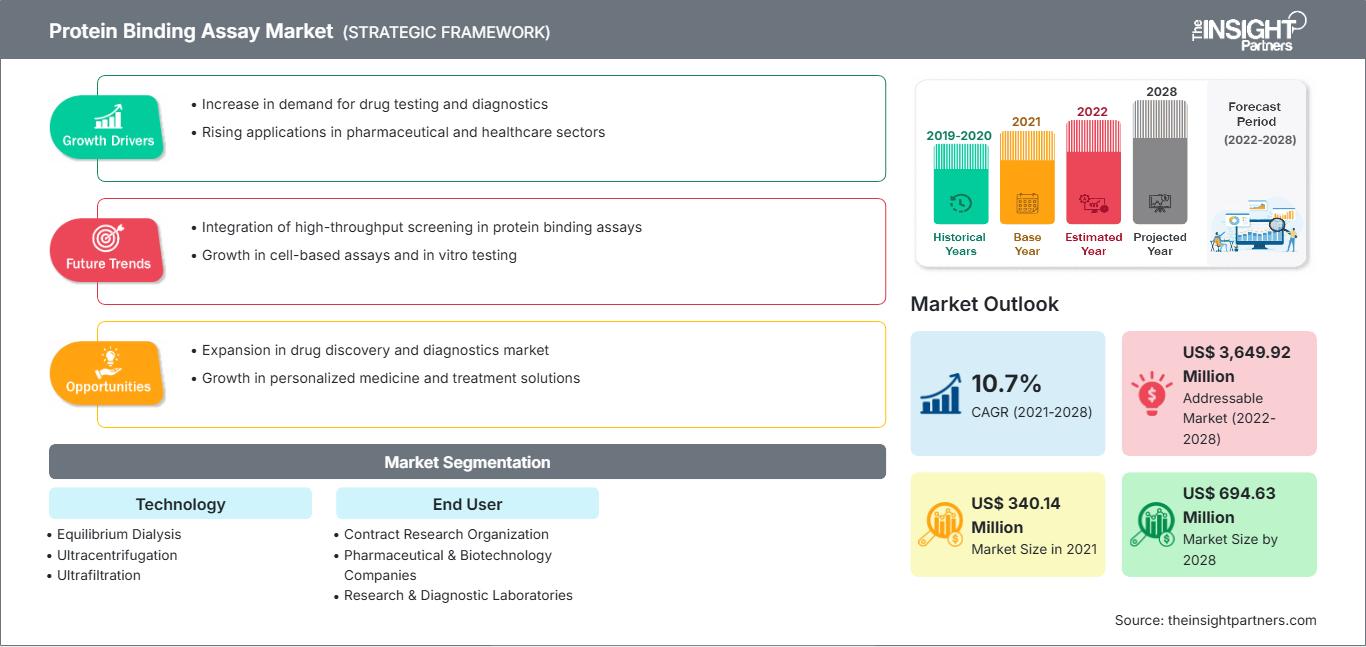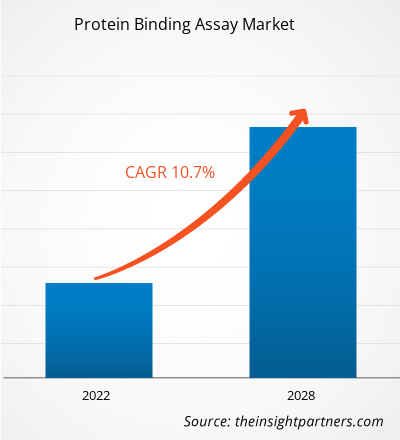Si prevede che il mercato dei test di legame proteico raggiungerà i 694,63 milioni di dollari entro il 2028, rispetto ai 340,14 milioni di dollari del 2021; si stima una crescita a un CAGR del 10,7% dal 2021 al 2028.
I test di legame proteico aiutano ad analizzare l'interazione tra due tipi di proteine. Questi test sono ampiamente utilizzati nel processo di sviluppo di nuovi farmaci.
Il mercato dei test di legame proteico è segmentato in base a tecnologia, utente finale e area geografica. Per area geografica, il mercato è ampiamente segmentato in Nord America, Europa, Asia-Pacifico, Medio Oriente e Africa, America meridionale e centrale. Il rapporto offre approfondimenti e analisi approfondite del mercato, sottolineando parametri quali tendenze di mercato, progressi tecnologici e dinamiche di mercato, insieme all'analisi del panorama competitivo dei principali attori del mercato a livello globale.
Approfondimenti di mercato
Personalizza questo rapporto in base alle tue esigenze
Potrai personalizzare gratuitamente qualsiasi rapporto, comprese parti di questo rapporto, o analisi a livello di paese, pacchetto dati Excel, oltre a usufruire di grandi offerte e sconti per start-up e università
Mercato dei test di legame proteico: Approfondimenti strategici

-
Ottieni le principali tendenze chiave del mercato di questo rapporto.Questo campione GRATUITO includerà l'analisi dei dati, che vanno dalle tendenze di mercato alle stime e alle previsioni.
Uno studio clinico è un passaggio cruciale e significativo nella determinazione della sicurezza e dell'efficacia di una strategia medica, di un trattamento e di un dispositivo per uso commerciale. Questi studi aiutano anche a comprendere e determinare i migliori approcci medici per una particolare area terapeutica. Prima dell'approvazione di molecole farmacologiche o dispositivi medici da parte delle autorità di regolamentazione, vengono condotti una serie di studi clinici. La crescente prevalenza di malattie trasmissibili e non trasmissibili sta innescando la domanda di sviluppo di nuovi farmaci e dispositivi medici, che a sua volta stimola la domanda di test di legame proteico. Secondo i dati della National Library of Medicine degli Stati Uniti, nel 2018 erano in corso circa 280.801 studi clinici in 50 stati e 204 paesi. La figura seguente mostra l'aumento del numero di studi registrati nel periodo compreso tra il 2015 e il 2020.
-
Numero di studi registrati per sperimentazioni cliniche
|
Anno di prima pubblicazione |
Studi all'inizio dell'anno |
Studi durante l'anno |
Studi alla fine dell'anno Anno |
|
2015 |
181.304 |
24.130 |
205.434 |
|
2016 |
205.434 </ td> |
27.809 |
233.243 |
|
2017 |
233.243 |
29.198 |
262.441 |
| < p>2018 |
262.441 |
17.836 |
280.277 |
|
2019 |
293.275 |
32.519 |
325.794 |
|
2020 |
325.794 |
36.740 |
362.534 |
Inoltre, Le aziende farmaceutiche, di dispositivi medici e biotecnologiche si concentrano sulle attività di ricerca e sviluppo (R&S) per sviluppare nuove molecole per applicazioni terapeutiche con il massimo potenziale medico e commerciale. Le aziende investono in modo significativo in R&S con l'obiettivo di fornire al mercato prodotti innovativi e di alta qualità.
-
I 10 maggiori investitori in R&S nel settore farmaceutico, 2019
|
Nome dell'azienda (Budget R&S in % del fatturato) |
Nome dell'azienda (Budget R&S in % del fatturato) |
|
1. F. Hoffmann La-Roche Ltd. (19,0%) |
2. Johnson & Johnson Johnson Services, Inc. (13,8%) |
|
3. Merck KGaA (21,1%) |
4. Novartis AG (19,8%) |
|
5. Pfizer, Inc. (16,7%) |
6. Sanofi SA (16,7%) |
|
7. AbbVie, Inc. (19,0%) |
8. Bristol Myers Squibb Company Limited (23,6%) |
|
9. AstraZeneca Plc. (24,8%) |
10. GlaxoSmithKline Plc (13,8%) |
Nelle prime fasi del processo di sviluppo di un farmaco, vengono sviluppati saggi di legame proteico. Poiché i farmaci circolanti non legati hanno il miglior accesso ai bersagli e alle vie di escrezione, il legame del farmaco candidato alle proteine plasmatiche è cruciale per la distribuzione, l'efficacia e la definizione del margine di sicurezza del farmaco. Secondo Statista, circa 7.493 farmaci sono entrati nella fase preclinica nel 2017 e si stima che il numero raggiungerà gli 8.040 nel 2018. Di conseguenza, il numero totale di farmaci candidati sottoposti a screening ogni anno è in aumento. Gli studi di legame proteico, condotti nelle prime fasi del processo di sviluppo di un farmaco, rappresentano un aspetto importante della fase preclinica. Pertanto, l'aumento delle attività di scoperta di nuovi farmaci, unito all'aumento della spesa in ricerca e sviluppo farmaceutica, guida la crescita del mercato dei test di legame proteico.
La crescente necessità di ridurre i costi di scoperta e sviluppo di farmaci contribuisce in modo significativo alla crescita del mercato dei test di legame proteico
Il costo di sviluppo di nuovi farmaci rimane elevato, a un ritmo tale da far crollare l'inflazione, e i rendimenti e i profitti degli investimenti sono in calo, esercitando pressione sull'intero sistema della medicina innovativa. Molte aziende di ricerca farmaceutica e biofarmaceutica stanno rivalutando le vecchie politiche di ricerca e sviluppo e concentrando i propri sforzi sul miglioramento dell'efficienza, sull'aumento della produzione e sulla soddisfazione delle esigenze insoddisfatte dei pazienti, a causa delle attuali pressioni economiche e politiche per ridurre i costi sanitari. Il cambiamento di focus sulla scoperta e lo sviluppo di farmaci e il crescente utilizzo di nuove tecnologie per l'identificazione e lo screening di candidati farmacologici stanno consentendo al personale di ricerca di accedere a diversi segmenti di malattie croniche, degenerative e potenzialmente letali che in precedenza non erano presi di mira.
La scoperta e lo sviluppo di farmaci sono processi costosi in quanto richiedono investimenti in finanziamenti, risorse umane e tecnologie. Prima di lanciare un nuovo farmaco sul mercato, è necessario rispettare rigorosamente le normative in materia di test e standard di produzione. Inoltre, il fallimento di un candidato farmaco durante la fase di sviluppo comporta lo spreco dell'intero investimento. Gli studi sul legame proteico aiutano a valutare le capacità di legame e assorbimento nelle fasi precliniche, con conseguente riduzione dell'attrito farmacologico nelle fasi successive dello sviluppo, contribuendo a ottimizzare i costi di scoperta dei farmaci. Pertanto, la crescente necessità di ridurre i costi del processo di scoperta e sviluppo di farmaci sta alimentando la crescita del mercato dei test di legame proteico.
Approfondimenti tecnologici
In base alla tecnologia, il mercato globale dei test di legame proteico è segmentato in ultracentrifugazione, ultrafiltrazione, dialisi all'equilibrio, plasmone di superficie e altri. Nel 2020, il segmento della dialisi all'equilibrio deteneva la quota maggiore del mercato. Tuttavia, si prevede che il segmento dell'ultrafiltrazione registrerà il CAGR più elevato sul mercato tra il 2021 e il 2028. La dialisi all'equilibrio è tra i metodi più ampiamente accettati per la valutazione del legame proteico e può essere eseguita con l'ausilio di dispositivi di dialisi all'equilibrio rapido (RED). I ricercatori preferiscono questo metodo poiché presenta minori effetti di legame a fattori estranei e indesiderati che influenzano i risultati della ricerca.
Informazioni per l'utente finale
In base all'utente finale, il mercato dei test di legame proteico è segmentato in organizzazioni di ricerca a contratto, aziende farmaceutiche e biotecnologiche e laboratori di ricerca e diagnostica. Si prevede che il segmento delle aziende farmaceutiche e biotecnologiche deterrà la quota di mercato maggiore nel 2021. Si prevede inoltre che diventeranno il principale azionista del mercato entro il 2028. Queste aziende sono le principali utilizzatrici di servizi CRO; si rivolgono alle CRO per l'outsourcing della ricerca e sviluppo di farmaci e molecole. Il legame proteico è un processo biochimico fondamentale utilizzato per studiare il meccanismo d'azione dei farmaci e i loro effetti farmacologici sui soggetti. Questi aspetti stanno spingendo il mercato dei test di legame proteico per il segmento delle aziende farmaceutiche e biotecnologiche.
Lanci di prodotti, fusioni e acquisizioni sono strategie ampiamente adottate dagli operatori che operano nel mercato globale dei test di legame proteico. Di seguito sono elencati alcuni dei recenti sviluppi di prodotti chiave:
A novembre 2020, Pharmaron Beijing Co., Limited ha acquisito il 100% delle attività di Absorption Systems, USA, per un importo massimo di 137,5 milioni di dollari in contanti. Absorption Systems è un'organizzazione di ricerca a contratto (CRO) scientifica e non clinica leader che fornisce piccole e grandi molecole, terapie cellulari e geniche e dispositivi oculari e medici, tra gli altri, ad aziende farmaceutiche, biotecnologiche e di dispositivi medici; agenzie di regolamentazione; enti di ricerca e sperimentazione.
Ad aprile 2020, Sartorius ha acquisito con successo alcune attività di Danaher Life Sciences. La transazione è stata completata dopo aver ottenuto le necessarie autorizzazioni normative.
Il ritmo della ricerca e sviluppo di farmaci e vaccini contro la malattia è aumentato durante la pandemia di COVID-19. Il legame proteico è uno dei principali fenomeni biochimici studiati durante il processo di sviluppo dei farmaci, poiché i recettori cellulari a cui si legano gli antigeni sugli agenti infettivi o sulle molecole dei farmaci sono per lo più di natura proteica. Pertanto, le aziende farmaceutiche e biotecnologiche che investono in innovazioni di prodotto necessitano spesso di materiali e attrezzature per il test di legame proteico.
Approfondimenti regionali sul mercato dei test di legame proteico
Le tendenze regionali e i fattori che influenzano il mercato dei test di legame proteico durante il periodo di previsione sono stati ampiamente spiegati dagli analisti di The Insight Partners. Questa sezione illustra anche i segmenti e la geografia del mercato dei test di legame proteico in Nord America, Europa, Asia-Pacifico, Medio Oriente e Africa, America Meridionale e Centrale.
Ambito del rapporto di mercato sui test di legame proteico
| Attributo del rapporto | Dettagli |
|---|---|
| Dimensioni del mercato in 2021 | US$ 340.14 Million |
| Dimensioni del mercato per 2028 | US$ 694.63 Million |
| CAGR globale (2021 - 2028) | 10.7% |
| Dati storici | 2019-2020 |
| Periodo di previsione | 2022-2028 |
| Segmenti coperti |
By Tecnologia
|
| Regioni e paesi coperti |
Nord America
|
| Leader di mercato e profili aziendali chiave |
|
Densità degli attori del mercato dei test di legame proteico: comprendere il suo impatto sulle dinamiche aziendali
Il mercato dei test di legame proteico è in rapida crescita, trainato dalla crescente domanda degli utenti finali dovuta a fattori quali l'evoluzione delle preferenze dei consumatori, i progressi tecnologici e una maggiore consapevolezza dei benefici del prodotto. Con l'aumento della domanda, le aziende stanno ampliando la propria offerta, innovando per soddisfare le esigenze dei consumatori e sfruttando le tendenze emergenti, alimentando ulteriormente la crescita del mercato.

- Ottieni il Mercato dei test di legame proteico Panoramica dei principali attori chiave
Il mercato globale dei saggi di legame proteico è segmentato in base a tecnologia, utente finale e area geografica. Il mercato, in base alla tecnologia, è suddiviso in ultracentrifugazione, ultrafiltrazione, dialisi all'equilibrio, plasmone di superficie e altri. In base all'utente finale, il mercato dei saggi di legame proteico è suddiviso in organizzazioni di ricerca a contratto, aziende farmaceutiche e biotecnologiche e laboratori di ricerca e diagnostica. Il mercato, in base all'area geografica, è ampiamente segmentato in Nord America, Europa, Asia-Pacifico, Medio Oriente e Africa, America meridionale e centrale.
Profili aziendali
- Thermo Fisher Scientific, Inc.
- Merck KGaA
- Eurofins Scientific
- General Electric Company
- Sovicell GmbH
- Pharmaron Beijing Co., Ltd.
- Biotium, Inc.
- MicroConstants, Inc.
- Sartorius AG
- Analisi storica (2 anni), anno base, previsione (7 anni) con CAGR
- Analisi PEST e SWOT
- Valore/volume delle dimensioni del mercato - Globale, Regionale, Nazionale
- Industria e panorama competitivo
- Set di dati Excel
Report recenti
Testimonianze
Motivo dell'acquisto
- Processo decisionale informato
- Comprensione delle dinamiche di mercato
- Analisi competitiva
- Analisi dei clienti
- Previsioni di mercato
- Mitigazione del rischio
- Pianificazione strategica
- Giustificazione degli investimenti
- Identificazione dei mercati emergenti
- Miglioramento delle strategie di marketing
- Aumento dell'efficienza operativa
- Allineamento alle tendenze normative






















 Ottieni un campione gratuito per - Mercato dei test di legame proteico
Ottieni un campione gratuito per - Mercato dei test di legame proteico